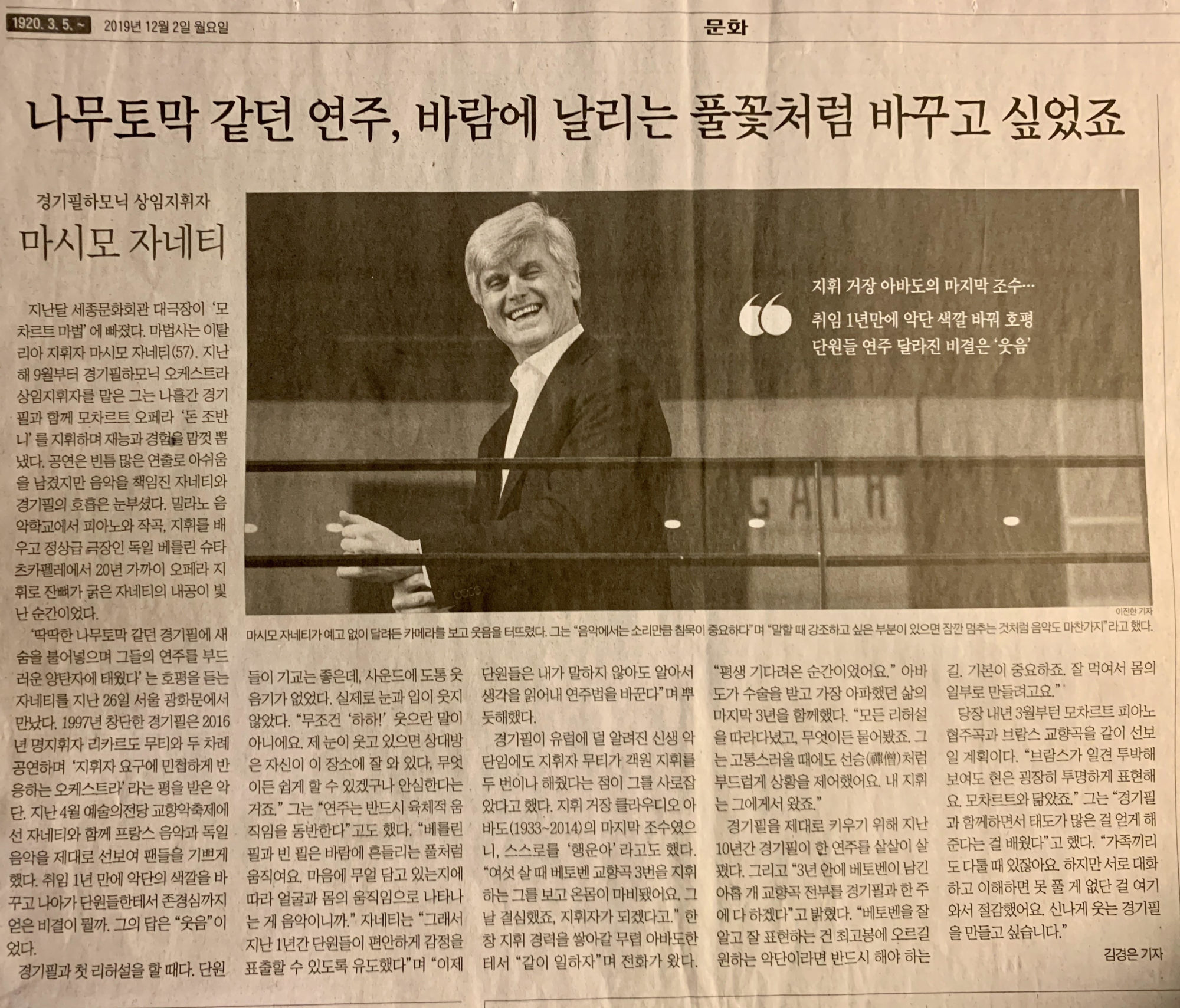One year after his inauguration, he changed the color of the orchestra and gained popularity. The key to the different playing is the “smiles” of the members.
Last month, Grand Theater of the Sejong Center for the Performing Arts fell in love under the spell of the magic of Mozart’s music. The mage was Italian conductor Massimo Zanetti .
Since September 2018, he has taken over the position as Music Director of the Gyeonggi Philharmonic Orchestra. In October 2019 he conducted Mozart “Don Giovanni” where he fully showcased his talents and experiences: the way in which Zanetti and the Gyeonggi Philharmonic Orchestra worked together was breathtaking, allowing his inner power to shine.
On January 26, in Gwanghwamun, Seoul, I met Zanetti at a time when the acclaimed conductor was receiving such positive comments as, “[Zanetti is] breathing fresh air into Gyeonggi philharmonic orchestra which was like a wooden block, he brought its performance on soft grass field.” Founded in 1997, Gyeonggi Philharmonic Orchestra gained a reputation as “an orchestra that responds quickly to the demands of the conductor” after its two performances with Ricardo Muti in 2016. In April this year, at the Korean Orchestra Festival at the Seoul Arts Center, Gyeonggi Philharmonic Orchestra showcased French and German music with Zanetti and delighted its fans. What is the secret of changing the color of the orchestra and gaining respect from the members in one year? His answer: smiling.
At the first rehearsal with Gyeonggi Philharmonic Orchestra, the members were fine, but there was no “joy” in the sound. The eyes and mouths of the orchestra members were not smiling at all.
“By smiling, I don’t mean that they should laugh, but if my eyes are rejoicing while making music together, the orchestra percieves a positive athmosphere, making the work easier” said Zanetti. “In an orchestra, music should be created by an harmonic and elegant movement flow that passes through the bodies . Top orchestras like The Berlin or Vienna Philharmonic move like grass swinging in the wind: music is at the same time sound and what appears in the movement bodies and on the face’s expressions, depending on what the heart feels. I’ve encouraged them to express their feelings comfortably: now the members read my thoughts and change the way they play even without speaking”, he added proudly.
Although Gyeonggi Philharmonic was a young orchestra less well known in Europe, the fact that Muti had performed twice with the orchestra captured Zanetti’s attention. Zanetti, who was also assistant of maestro Claudio Abbado(1933-2014), said “When I was six years old, I saw him [Abbado] conducting Beethoven’s Symphony No. 3 and my whole body was paralyzed. I decided that day to become a conductor.”
By the time he was building his career, Abbado contacted him and suggested that they work together. “That was the moment I’ve been waiting for years,” said Zanetti, “I followed him to all the rehearsals and asked him everything I wanted to know.The way I conduct reflex all of what I learned from him”.
In order to properly develop the orchestra, Zanetti studied carefully the perfoming history of the Gyeonggi Philharmonic Orchestra. He unveiled his wish: “ Within three years, I would like to perform all the nine Beethoven’s Symphonies during a week-long Cycle” he said, “It is one of the main achievements for top-level orchestras “.
In March next year, the orchestra will perform a double program with Mozart and Brahms works.
“While working together with Gyeonggi Philharmonic Orchestra, I have learned that a postive attitude can change many things; in all the families there can be discussions and differences, but by talking and understanding each other, there is nothing you can’t solve.
I want to bring a creative and joyful atmosphere into Gyeonggi Philharmonic Orchestra.”
